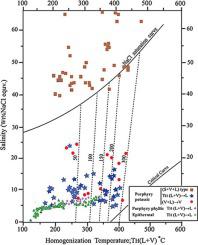Ore Geology Reviews ( IF 3.2 ) Pub Date : 2021-05-14 , DOI: 10.1016/j.oregeorev.2021.104196 Rasoul Ferdowsi , Ali Asghar Calagari , Vartan Simmonds , Azinsadat Miranvari

|
The Astarghan area in northwest Iran (~50 km north of Tabriz) represents an excellent example of coexisting and associated skarn, porphyry and epithermal mineralizations of copper and gold. This contribution aims to study the geology, alteration and mineralization in these deposits, as well as the occurrence of gold and its host minerals, and present the physico-chemical characteristics of ore-forming fluids and the sulfur origin, in order to get a better understanding of development and evolution of these mineralizations. The Astarghan porphyry stock (Oligo–Miocene) intruded the upper Cretaceous flysch-type sedimentary sequence (calcareous sandstone and limestone with intercalations of siltstone, shale and marl) and brought about metamorphism and metasomatism along the contact. The Cu–Au mineralization in the Astarghan area occurred mainly in three forms: (1) skarn patches along the contact (Zone A), (2) stockwork-type and disseminated porphyry mineralization within the potassic (at Kaghdara and Boiokwari areas) and phyllic (at Sildirimdara area) alteration zones (Zone B), and (3) native gold-bearing low-sulfidation epithermal veins within the argillic alteration zone at Nowrozkala area (Zone C). The micro-thermometric studies on the porphyry-type Kaghdara potassic alteration zone showed that homogenization temperatures for liquid-rich and vapor-rich 2-phase, as well as halite-bearing multiphase inclusions range about 160–420 °C, 220–460 °C, and 320–580 °C, respectively. Salinities of the 2-phase and multiphase inclusions have ranges of 5–25 and 40–70 wt% NaCleq., respectively. However, fluid inclusions present in the epithermal veins of Nowrozkala are mainly liquid-rich 2-phase, and their homogenization temperature and salinity values lie within the ranges of 118–325 °C and 0.6–7.4 wt% NaCleq., respectively. The approximate estimated depth of the sulfide and gold mineralization in the porphyry system ranges from 1.6 to 2.5 km, and in the epithermal system is < 0.9 km. The sulfur isotopic analysis of pyrite from the porphyry and epithermal mineralizations in the potassic alteration zone at Kaghdara and argillic alteration zone at Nowrozkala indicate that the δ34S values (–0.1 to –0.3 and –0.5 to –1.1‰, respectively) are close to the range of magmatic sources. Finally, electron probe micro-analyses indicate that besides independent particles of 50–200 μm in the epithermal veins, gold is mainly hosted by tetrahedrite within the porphyry-related phyllic alteration zone, but especially stibnite within the epithermal veins; these minerals, as well as epithermal polyhedral pyrites contain native gold inclusions.
中文翻译:

伊朗西北部 Astarghan 地区斑岩储量和相关矽卡岩带和超热液脉中金(铜)矿化的演化:来自流体包裹体、矿物化学和硫同位素分析的证据
伊朗西北部的 Astarghan 地区(大不里士以北约 50 公里)是铜和金共存和伴生的矽卡岩、斑岩和浅成热液矿化的一个很好的例子。本贡献旨在研究这些矿床的地质、蚀变和成矿作用,以及金及其寄主矿物的赋存情况,并呈现成矿流体的理化特征和硫的成因,以期更好地了解这些矿床的地质、蚀变和成矿作用,以及金及其寄主矿物的赋存情况,并呈现成矿流体的理化特征和硫的成因。了解这些矿化的发展和演化。阿斯塔干斑岩(渐新世-中新世)侵入上白垩统复理石型沉积层序(钙质砂岩和石灰岩夹粉砂岩、页岩和泥灰岩),沿接触带发生变质和交代作用。Astarghan 地区的铜金矿化主要以三种形式出现:(1)沿接触面(A 区)的矽卡岩斑块;(2)钾质内(Kaghdara 和 Boiokwari 地区)和叶状斑岩矿化(在 Sildirimdara 地区)蚀变带(B 区),以及(3)Nowrozkala 地区(C 区)泥质蚀变带内的原生含金低硫化超热液脉。斑岩型Kaghdara钾质蚀变带的微热学研究表明,富液和富蒸气的两相以及含盐分盐的多相夹杂物的均质温度范围约为160–420°C,220–460° C 和 320–580 °C,分别。两相和多相包裹体的盐度范围为 5-25 和 40-70 wt% NaCl (2) 钾质(Kaghdara 和 Boiokwari 地区)和叶状(Sildirimdara 地区)蚀变带(B 区)内的网状和浸染斑岩矿化,以及(3)泥质内含原生金的低硫化浅成热液脉Nowrozkala 地区(C 区)的蚀变带。斑岩型Kaghdara钾质蚀变带的微热学研究表明,富液和富蒸气的两相以及含盐分盐的多相夹杂物的均质温度范围约为160–420°C,220–460° C 和 320–580 °C,分别。两相和多相夹杂物的盐度范围为5–25和40–70 wt%NaCl (2) 钾质(Kaghdara 和 Boiokwari 地区)和叶状(Sildirimdara 地区)蚀变带(B 区)内的网状和浸染斑岩矿化,以及(3)泥质内含原生金的低硫化浅成热液脉Nowrozkala 地区的蚀变带(C 区)。斑岩型 Kaghdara 钾蚀变带的显微测温研究表明,富液富汽两相以及含岩盐多相包裹体的均质温度范围约为 160-420°C、220-460° C 和 320–580 °C,分别。两相和多相包裹体的盐度范围为 5-25 和 40-70 wt% NaCl (3) 诺鲁兹卡拉地区(C 区)泥质蚀变带内的天然含金低硫化超热液脉。斑岩型 Kaghdara 钾蚀变带的显微测温研究表明,富液富汽两相以及含岩盐多相包裹体的均质温度范围约为 160-420°C、220-460° C 和 320–580 °C,分别。两相和多相包裹体的盐度范围为 5-25 和 40-70 wt% NaCl (3) 诺鲁兹卡拉地区(C 区)泥质蚀变带内的天然含金低硫化超热液脉。斑岩型 Kaghdara 钾蚀变带的显微测温研究表明,富液富汽两相以及含岩盐多相包裹体的均质温度范围约为 160-420°C、220-460° C 和 320–580 °C,分别。两相和多相包裹体的盐度范围为 5-25 和 40-70 wt% NaCl 和分别为320–580°C。两相和多相包裹体的盐度范围为 5-25 和 40-70 wt% NaCl 和 320–580 °C,分别。两相和多相夹杂物的盐度范围为5–25和40–70 wt%NaCl等式 , 分别。然而,Nowrozkala 超热液脉中存在的流体包裹体主要是富含液体的两相,它们的均质温度和盐度值在 118-325 °C 和 0.6-7.4 wt% NaCl eq 范围内。, 分别。斑岩系统中硫化物和金矿的估计深度约为1.6至2.5 km,超热系统中的深度小于0.9 km。卡格达拉钾蚀变带和诺鲁兹卡拉泥质蚀变带斑岩和超热液矿化黄铁矿硫同位素分析表明,δ 34S值(分别为–0.1至–0.3和–0.5至–1.1‰)接近岩浆源范围。最后,电子探针显微分析表明,除了超热液脉中50-200 μm的独立颗粒外,金主要以与斑岩相关的叶状蚀变带内的四面体矿物为主体,尤其是超热液脉内的辉锑矿;这些矿物以及超热多面体黄铁矿都含有天然的金包裹体。











































 京公网安备 11010802027423号
京公网安备 11010802027423号